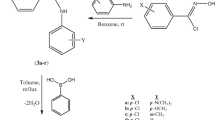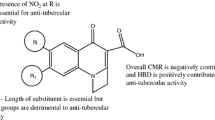Abstract
A series of ricinoleic acid derivatives has been synthesized and tested for antibacterial activity with respect to four standard strains. Dibromoricinoleic acid (DBRA) showed high activity comparable with that of the reference drug ciprofloxacin. QSARs between various physicochemical indices and the antibacterial activity of a training set including 12 compounds were analyzed. The topological parameter, the valence second-order molecular connectivity index (2χv), and the electronic parameter of total energy (TE) proved to be important for the antibacterial activity of compounds studied. The proposed QSAR models were validated using the leave-one-out procedure. The validity of these models was confirmed by predicting the activity of a set of three compounds (not present in the training set).
Similar content being viewed by others

References
B. Narasimhan, U. R. Kothawade, D. S. Pharande, et al., Indian J. Chem., 42B, 2828–2834 (2003).
B. Narasimhan, D. Belsare, D. Pharande, et al., Eur. J. Med. Chem., 39, 827–834 (2004).
B. Narasimhan and A. S. Dhake, J. Med. Food, 9(3), 395–399 (2006).
S. Budavari, in: The Merck Index (12th Ed.), Merck Research Lab., White House Station, NJ (1996).
H. V. Ammon, P. J. Thomas, and S. F. Philips, J. Clin. Invest., 53, 374–379 (1974).
E. Beubler and H. Jaun, J. Pharm. Pharmacol., 31, 681–685 (1979).
V. Celme, S. Evangelista, R. Cirillo, et al., Mediat. Inflamm., 9(5), 223–228 (2000).
S. J. Lin, S. L. Lee, and C. C. Chon, J. Ferm. Bioeng., 82(1), 42–45 (1996).
R. Ikan, in: Natural Products: A Lab Guide, Academic Press, London (1969), pp. 28–30.
J. G. Cappucino and N. Sherman, in: Microbiology: A Laboratory Manual, Addison Wesley, San-Francisco, CA (1999), pp. 263–265.
Pharmacopoeia of India, Ministry of Health Department, Government of India, New Delhi (1996), Vol. II, p. A–88.
H. Kubinyi, QSAR-Hansch analysis and Related Approaches, VCH Publishers, New York (1993), Vol. 1, pp. 1–117.
C. Hansch, Comprehensive Medicinal Chemistry, Pergamon Press, Oxford (1990), Vol. 4, pp. 9–528.
TSAR 3D (Version 3.3), Oxford Molecular Limited, 2000.
Author information
Authors and Affiliations
Additional information
__________
Translated from Khimiko-Farmatsevticheskii Zhurnal, Vol. 41, No. 3, pp. 16–21, March, 2007.
Rights and permissions
About this article
Cite this article
Narasimhan, B., Mourya, V.K. & Dhake, A.S. QSAR studies of antibacterial ricinoleic acid derivatives. Pharm Chem J 41, 133–139 (2007). https://doi.org/10.1007/s11094-007-0030-5
Received:
Issue Date:
DOI: https://doi.org/10.1007/s11094-007-0030-5



